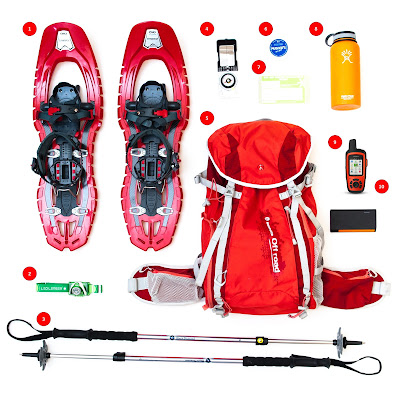Snowshoeing Checklist | 10 Items We Cary on Every Outing
Let's face it, if you live in the northern regions of the United States, winters can seemingly go on forever. Snow tends to accumulate even before it is officially winter. By the time February rolls around you are suffering from the age-old Cabin-Fever and need to get out of the house. Luckily with snow comes the opportunity for great snowshoeing. Over the last few years, Krista and I have jumped headlong into this Nordic sport and it has changed the way we view winter - It affords us the opportunity to explore a world transformed by snow. Here are the essential items we take on every one of our snowshoe outings.
 1. Snowshoes
1. Snowshoes
I cannot believe how much snowshoes have evolved in the last few years. Aluminum frames and flimsy plastic decks have given way to carbon fiber and space-age polymers. I purchased a pair of TSL Symbioz Elite shoes back in 2015 and absolutely love them. Unlike conventional metal-framed shoes, the Symbioz hour-glass design allows for a more natural stride and their flexible design adapts well to uneven terrain.
2. Headlamp
Krista and I tend to hit the snowshoe trails after work and find our headlamps to be indispensable. Not only do they light up the trails on night hikes, but they are great when trying to put our gear away back at the car. We prefer headlamps with adjustable beam patterns and multiple output settings. Snow on the ground helps to spread out the light and we find we don't need as bright of a headlamp when snowshoeing that we would when hiking at night in the summer.
3. Hiking Poles
Although I don't typically use poles when hiking I find them invaluable while snowshoeing. I have a bad knee and hiking poles, with upgraded snow baskets, help with my stability and prevent twisting injuries. They also work great when traversing across slopes or trudging through deep snow. We prefer adjustable poles, which can be lengthened or shortened for ascents or descents. The key is to find a pair with a maximum length that is a few inches longer than the distance from your elbow to the ground.
4. Compass
I know this seems a bit archaic, but packing a compass (and a map of the trail system) could save your life. It is easy to get turned around while snowshoeing, even on trails you hike in the summer. Although many of the trails we snowshoe on are within cellular coverage areas, cold can zap the batteries in smartphones. We find it just as easy to pull out our map and compass to see where we are.
5. Hiking Day-Pack
The weather here in Wyoming can change in an instant, especially in the winter. I always pack extra layers, water, and beef jerky in a simple hiking day/camera-pack with my compass and headlamp. I really like Manfrotto's Off-Road line of backpacks for trips like this. I can easily store/access my cameras in a lower side-zipper compartment, and there is still plenty of room in the top for a day's worth of gear.
6. Dog Pad Wax
We don't go anywhere without our two dogs, Gus and Barley. Although we always fit them with water-resistant dog shoes, the duo run hard enough that one of them will inevitably lose a shoe. We have found an application of Musher's Secret on the paws before we fit them with shoes, and sometimes apply mid-hike, really helps prevent snow from building up between their pads. The combination of this and their shoes ensures the two have a great time.
7. Trail Permit
Although not necessary at all locations, we were required to purchase a backcountry trail permit for our 2016 snowshoeing trip to the base of Mt. Batchelor. Most nordic centers require you to purchase trail permits if you will be using their groomed trails.
8. Insulated Water Bottle
It gets cold here in Wyoming, and we have had water bottles begin to freeze up while on hikes. To combat this, we will fill our vacuum-insulated water bottles and store them in our packs. Not only are these things great for keeping water cold while on summer hikes, but they also do a great job of keeping water warm while on snowshoeing outings.
9. Satellite Communications
I know, with all of the GPS-enabled devices on the market, and my insistence on packing a compass and paper map, it may not make sense to carry something like Garmin's inReach. We love these types of devices and, although we are nolonger ambassadors for Garmin/DeLorme, we still advocate for their use. Many of the places we vist are "off the beaten path" and outside of cellular service. Devices like these ensure you can keep in contact with loved ones while you are in the backcountry.
10. Backup Battery Pack
Winter's chill not only affects my joints (I know I sound old...) but it also "zaps" the energy out of the batteries in our electronic devices. I like tossing a small battery pack in the backpack to ensure my cell phone and GoPro stay charged while we are on the trail.
Beau Johnston is an engineer, writer, and photographer who is dedicated to proving you can find a balance between work and life. He is the Co-Founder and Publisher of Living Overland, and when he isn't working, you can find him exploring National Parks, fly fishing, and camping with his wife (Krista) and their two dogs.
___________________________
If you found this review helpful, please consider using one of the affiliate links below. The price is the same for you, but a small percentage of the purchase price goes to us, which helps keep this site going. Thank you!
